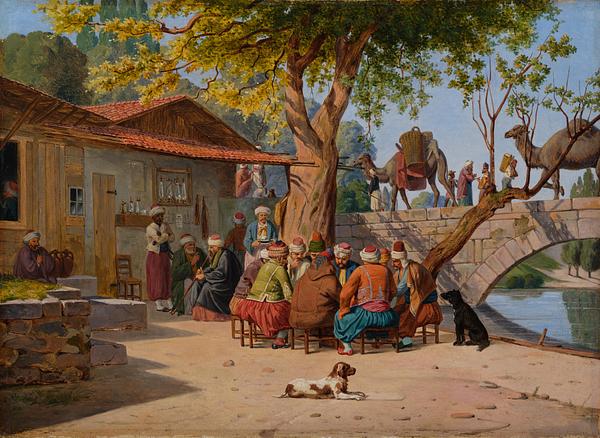The year after his return from a long trip abroad in the years 1834–1837, which took him to many places, including Turkey (
16/1990), Martinus Rørbye became a member of the Academy in Copenhagen. At the time, prospective members had to do a so-called admission piece representing a subject set by the Academy. In the case of painters, the nature of the subject was determined by the genre in which the relevant artist had specialised. Thus, Rørbye was tasked with producing a genre scene, specifically one set in Turkey because his work from the Orient had been met with unusually great interest.
[1]On his journey by steamship from the Greek city of Piraeus to Constantinople (present-day Istanbul) in mid-December 1835, Rørbye and his travel companion, the architect Gottlieb Bindesbøll (1800–1856), spent a few days in the Turkish city of Smyrna (present-day Izmir). They explored the city and its sights together, including the Caravan Bridge. Rørbye could not draw it at the time due to cold weather, so he returned the following day, as he reports in his diary:
‘In the morning I strolled once again to the Ponte del Caravani, intending to draw a little, but things are still almost too fantastical here; one has hardly recovered after seeing some peculiar figure or thing before another, even more wondrous one presents itself. Long lines of camels leading and carrying black people, gaudy costumes everywhere, and a very beautiful landscape.”[2]The quote is among the best testimonies available to us about the fascinating, alien world that revealed itself to Rørbye in Smyrna, as no scenes from this place have been found among his many surviving drawings.
[3] Even so, he must have made records of some kind, because the following year he created his admission piece for the Academy,
Scene from Public Life in the Orient, for which the picture in The David Collection is a study.
[4] Today, there is nothing to confirm whether Rørbye made use of observations that he recorded on his journey to Constantinople or around Greece. However, the caravan bridge seems to resemble the real caravan bridge quite well. More conspicuous are the other components of the picture, such as the dromedaries and the oriental costumes.
